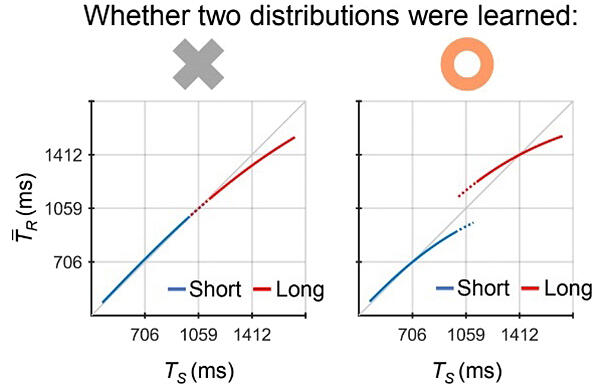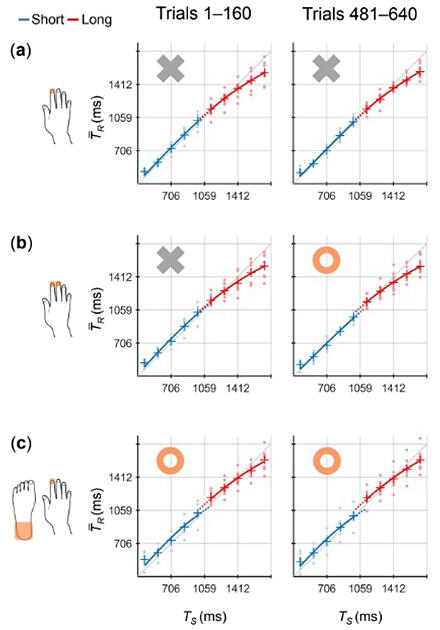Graduate Student Yoshiki Matsumura (at the time of the research) and Professor Makoto Miyazaki of the Department of Computer Science, the Faculty of Informatics at Shizuoka University, in collaboration with the University of Nottingham and the University of Bradford in the UK, have announced that they revealed "body-part specificity." This means using different body parts to generate responses to short and long distributions during a timing task allows the brain to concurrently learn these two independent statistical distributions. This was found by designing a timing task and conducting an experiment to evaluate participants' responses.
They demonstrated that learning independent distributions concurrently can be faster when using anatomically distant body parts, such as fingers and feet, rather than close body parts, such as the index and middle fingers. By means of learning independent distributions concurrently, baseball players can use different body parts to time their swings depending on the ball's speed for efficient learning. For example, they may use a foot for fastballs, while a hand may be used for slowballs. The results are expected to contribute to developing methods to improve sports skills and clarify the brain mechanisms that govern these skills. The work was published in the May 2 issue of the international journal npj Science of Learning.

The predictions based on the Bayesian estimation model: the mean response time intervals among trials () as a function of stimulus time interval (Ts) in the case that participants could not learn two independent distribution (left panel) and in the case that participants concurrently learned the short and long distributions (right panel).
Provided by Shizuoka University
Recently, it has become increasingly clear that the human brain performs estimation to maximize the success rate from statistical data of observed events based on Bayesian estimation. A variety of statistical distributions exist in daily tasks. For example, baseball pitching and hitting have a different distribution for each velocity (fastball and slowball) and course. People learn these, and their brains calculate the response with the highest probability of success. To learn these complex statistical distributions effectively using Bayesian estimation, multiple distributions need to be learned separately. However, the mechanisms underlying this process are not well understood.
In previous research, the group designed and tested timing tasks and showed that Bayesian estimation was performed during them. They also reported that there may be multiple timers, each associated with different body parts. In the present study, they examined the possibility that when two different statistical distributions are assigned to different body parts to generate responses to a timing task, participants can learn the two independent statistical distributions concurrently.
First, as a timing task, they designed an experiment where participants respond to the green light on the left and right fixation points (circles) on a display screen. Specifically, during an experiment, three sequential stimuli (S1→S2→S3) with either a short or long distribution were presented (lit) on either the left or right fixation point, and each participant responded. The time interval between any sequential stimuli was the same, and participants responded by predicting the onset of S3 based on the stimulus timing (Ts) of S1→S2. The time intervals presented were short (424-988 ms) and long distributions (1129-1694 s). For each participant, the right or left fixation point was randomly fixed to either the short or long distribution. After the participants understood whether the left or right side was faster or slower, each participant completed 640 trials of the response. The experiment included 5 main experiments and 2 preliminary experiments, with 8 participants in each experiment, for a total of 56 participants.

Participants performed the timing task using only the dominant index finger regardless of the distributions (short/long) (Experiment 1)
(a) selectively using the dominant index or middle finger according to the distributions (Experiment 2)
(b) and selectively using the contralateral hand or foot according to the distributions (Experiment 4)
(c) Grey crosses denote that participants could not learn the two independent distributions. Orange circles denote that participants concurrently learned the short and long distributions.
In addition, participants concurrently learned the two distributions from trials 1-160 also when selectively using the right or left index fingers (Experiment 3) and the ipsilateral hand or foot (Experiment 5)
Provided by Shizuoka University
In theoretical predictions according to the Bayesian estimation model, the curves of the mean response time intervals among trials × stimulus timing (Ts) function for the short and long distributions overlap and generalize if participants failed to concurrently learn the two independent distributions. In contrast, when they could concurrently learn the two independent distributions, the short and long distribution curves do not overlap, which evidences successful concurrent learning by the participants. They were able to confirm the validity of theoretical predictions actually through preliminary experiments and other means. Three experiments were conducted in the main experiments, in which participants used: 1) only the dominant index finger to generate all responses to the two distributions (short and long); 2) selectively used either the index or middle fingers of the dominant hand to generate responses according to the distributions; and 3) their dominant index finger or the ipsilateral foot to generate responses according to the distributions.
As a result, participants failed to learn the two independent distributions concurrently when they used only the index finger to generate the responses. In contrast, participants could concurrently learn the two independent distributions after the first 160 trials when they used the index and middle fingers to generate responses and during the first 160 trials when they used the index finger and the ipsilateral foot to generate.
Miyazaki said, "Moving forward, we plan to use virtual reality to verify the effectiveness of 'body-part specificity' in an environment closer to real sports. We are also interested in examining the relationship between sports experience/proficiency and the ability to learn different timing patterns. We also hope to conduct functional brain imaging studies to identify brain regions associated with the timing pattern learning ability."
Journal Information
Publication: npj Science of Learning
Title: Body-part specificity for learning of multiple prior distributions in human coincidence timing
DOI: 10.1038/s41539-024-00241-x
This article has been translated by JST with permission from The Science News Ltd. (https://sci-news.co.jp/). Unauthorized reproduction of the article and photographs is prohibited.




